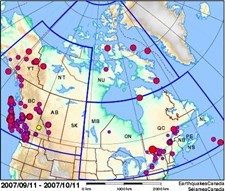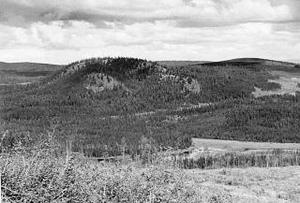
|
| ©Natural Resources Canada |
| Map of earthquake activity over the past 30 days |
John Cassidy of the Geological Survey of Canada said the region surrounding the remote volcano, known as the Nazko Cone, has experienced a "swarm" of over two dozen quakes a day since Oct. 10. The red volcanic rock cone is 16 kilometres from the village of Nazko, a community of about 200, and is 75 kilometres west of the town of Quesnel.

|
| ©Global Volcanism Program |
| Nazko Cone, the easternmost and youngest volcano of the Anahim volcanic belt in the Chilcotin-Nechako Plateau, central British Columbia |
"It will be fun. I'll be here [in Victoria] watching the data come in," Dr. Cassidy said. "Of course, this being B.C. we deal with earthquakes a few times a month ... but volcanoes are a rare occurrence in Canada. Of course, we don't know yet if it is a volcano. That is the big question."
The fact that the earthquakes are not any stronger than a magnitude of 3 and are taking place 28 kilometres below the Earth's crust may mean that magma is pooling for an eventual push to the surface, Dr. Cassidy said.
The four seismographs being deployed will allow the scientists in Vancouver and Victoria to measure whether the earthquakes are moving upward, a sign that the volcano could soon erupt.
"We're looking for movement in the earthquakes which would signify magma on the move. It would have to force its way through all of this old rock and make its way to the surface," Dr. Cassidy said.
"If there is a movement, say from 28 to 26 kilometres below the surface, then we'll be able to distinguish that later this week."
The small, tree-covered volcano is at the easternmost end of the 600-kilometre-long Anahim volcanic belt that stretches across central B.C. from Nazko to the Pacific Ocean. The site has not had an eruption for 7,500 years, and, with the most recent eruption in Canada being over 150 years ago, it would be a unique event for volcanologists, who normally have to visit other parts of the world to study volcanoes.
The cone, which runs along the Baezaeko forestry road, is currently the site of the only volcanic rock quarry in Canada.
Brian Wear, the president of Lightweight Advanced Volcanic Aggregates mining company, said five crew were currently working at the quarry and said that they plan to keep it open. The basalt and black pumice the company mines is used in construction projects across the country, he said.
"I like volcanoes, but most of my volcanology knowledge comes from being in this business for 21 years. I don't think this will put me out of business. If anything it will build inventory up for me," he said.
And while local residents have not felt the tremors, at least one has had an experience he plans to share with the scientists.
Rod McHone said he was building a road eight kilometres south of the cone a year ago when something triggered a strong reading from the instruments on his truck.
"We had an infrared temperature probe on the truck which tells you when you can use salt on the highway and stuff, and we passed a spot and the temperature immediately jumped up by nine degrees for about a kilometre as we drove through there," said Mr. McHone.
"I was wondering, 'What the hell, I got a temperature spike.' I looked around for hot springs and found nothing but now all this is happening."
He said the residents were looking forward to getting to the bottom of the geological mystery.
"No one has felt anything but it creates a bit of excitement around here," he said. "It gives you something to talk about. Nothing like that has ever happened."
Dr. Cassidy said any volcanic activity would be similar to the bubbly lava eruptions seen in Hawaii and would be mild, compared with the explosive force of Mount St. Helens, which killed 57 people in 1980.



Comment: One wonders, of course, if this report is in any way related to the following:
Geoscientist Receives Grant To Study Effects Of Volcanoes On Climate Change In Arctic